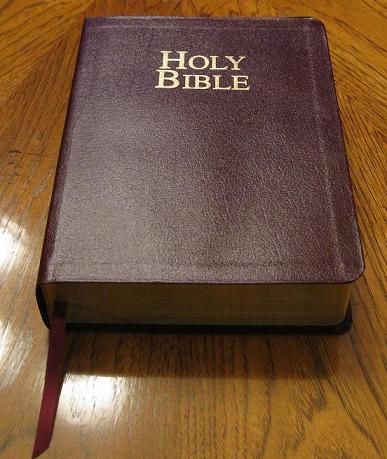

Rating
Price and Value
Scroll down to the bottom for pictures!
Summary of Features
Feature
Publication Date
1st Edition: 1970
7th (Leather) Edition: 2002 (reviewed here)
Cover
Burgandy Bonded Leather
Size
8.75 inches tall
6.25 inches long
1.75 inches thick
Binding
Glued
Thumb-Index Tabs
None
Text Format
Verse Format
Headings
KJV Headings in Top Margin
Mashiyach's Words in Red
No
Number of Ribbon Markers
1
Gold Gilded w/ Rounded Corners
Yes
Extensive Cross References
KJV Center Column
Helps
Sacred Name Introduction
Footnotes
Basic Alternative Renderings
Concordance
136 Page Extensive Concordance
Maps
None
Name of the Father
YAHVAH (all capitals)
Name of the Son
YAHSHUA (primarily)
YAHVAHSHUA (in certain cases)
Hebrew Transliterations
Only Elohim
Book Order
Greek Septuigant Order
Pentateuch
History/Poetry
Prophets
Western Greek Order
Gospels/Acts
Paul's Epistles
General Epistles
Revelation
Base Text
Rotherham's Emphasized Version
Old Archaic English
Yes
Manuscript Origin
Hebrew Masoretic Text(primary)
Greek Majority Text (primary)
Greek Critical Text (consulted)
Review
"The Restoration of the Original Sacred Name Bible" was first published in 1970 by "Missionary Dispensary Bible Research". Currently, they are now known as the "Sacred Name Bible Ministry" and publish it under the name "Rotherham Version: Sacred Names Restored" (hereby referred to as SNR). The 7th edition, published in 2002, finally came in a leather format which is the one being reviewed here. Prior to this it was only released in paperback (besides the initial hardcover version in 1970).
This was the second ever Sacred Name Bible released, the first being A.B. Traina's "Holy Name Bible" (New Testament released in 1950, full version released in 1963). The SNR Bible is considerably more accurate in it's translation though. Based on the Rotherham Version, it is very close to his translation with the exception of your typical Sacred Name revisions. These include the insertion of Elohim where "God" appears, elohim or deity (depending on the context) where "god" appears, Master appears where you find Lord (unless it's referring to YHWH in the NT, in which case it will be YAHVAH), Messiah replaces Christ, and Yahweh and Jesus have been changed to what they claim are the "Original Sacred Names". These names are YAHVAH (in all capital letters) for the Father, and the Son's name is YAHVAHSHUA. Most often, however, YAHVAHSHUA is printed in it's shortened form YAHSHUA (attracting a much bigger market since most prefer that pronunciation). As mentioned, they are put in all capital letters but there is no change in text formatting (like you often see in "old testaments" with the insertion of LORD) so it looks quite funny and jumps out at you. There is a fairly extensive introduction explaining the importance of the name and why they feel that YAHVAH and YAHVAHSHUA are the most correct forms of pronunciation for the name. It is mostly pseudo-scholarship at best, but if you're interested in the Sacred Names and this movement, you will find the information intriguing. Besides Yahweh, lord, god, and jesus christ though, all other words have remained virtually the same. Cross does not become "stake" (even though that is the more appropriate translation if you're coming from the Greek and not Jerome's Latin Vulgate), and crucify does not become "impale" as is often also changed in Sacred Name Bibles.
Before I get into my criticisms, let me point out what I like about this version. First, this is the only Sacred Name Bible to have center column references and subject headings. They are both from the KJV, so the cross references aren't as extensive as your popular versions like NASB or ESV, and the subject headings are only at the top of the page in the header. But, nonetheless, they are nice features that are lacking in other Sacred Name Bibles. On top of both of these, there is a very, very extensive concordance. The only other version that has a concordance is "The Word of Yahweh", but this one is much more exhaustive. It's 136 pages long in total. Whether the men behind the SNR Bible (most likely just L.D. Snow) put it together themselves or not is debatable, but it's nice to have nonetheless. I say it's debatable because it doesn't seem to fit with the rest of the book for some reason. Could just be bad judgment on my part though. The text is verse format.
Now, these features aside, there are a few issues. First, there is some misleading doctrinal articles in the beginning which promote SDA doctrine regarding the "ceremonial law" being "nailed to the cross". However, unlike A.B. Traina who inserts this sort of doctrine into the text of Hebrews, Romans and Galatians, SNR Bible leaves their commentary for the actual commentary. This is more than we can say for popular Scripture versions like the NLT, Good News Bible, or even worse, highly paraphrased versions such as The Message or The Living Bible. So, SNR Bible gets a thumbs up for that at least. The second issue is that Rotherham's Version is extremely literal to the point of not being very good English. It's bearable, but if you've read the more popular version "The Scriptures" by the Institute for Scripture Research and thought that reading was rough, you won't like this any better! There is quite a bit of old, archaic English as well. This isn't so bad if you're used to the King James Version, but even then, you'd probably want a version based on the King James (such as "The Word of Yahweh").
My number one complaint is probably the insertion of YAHVAH into the NT. We all know that it doesn't exist in the Greek manuscripts, so it's always guesswork when it comes to inserting the name. Sacred Name Bibles when they do this can go either one of two directions. They can be somewhat conservative and only replace "Lord" when it's referring to the Father, or they can be very liberal and replace most (or all) instances of "god" as well. The SNR Bible opts for the latter, and when this happens, you just get way too far off base. If the manuscript says theos/alaha/god, change it to Elohim! No need to put the Father's name where we KNOW it wouldn't of been. Changing the Word like this brings the rating for the SNR Bible down quite a bit.
As mentioned, besides the names, the translation really doesn't change much from Rotherham's Version. However, there are a few instances that I've been able to note.
-Isaiah 9:6
UNDER CONSTRUCTION
As far as the actual binding and such goes, for a glued bonded leather version, it's actually pretty good! The book does not stay open flat until you get into Leviticus though, but the pages are glued really well and flip very smoothly (no crinkling like in "The Word of Yahweh"). In fact, these are some of the nicest pages I've seen on a Sacred Name Bible. Not as "bible paper-ish" quality as the "Holy Name Bible", but this only means that there is less bleed through, which is a good thing. The gold gilding and rounded corners are really well done and the pages are very flush. Much, much better than the "The Sacred Scriptures: Bethel Edition", which is also a glued bonded leather binding. The size is great! At 8.75 inches tall by 6.25 inches long and 1.75 inches thick, it is perfect for carrying and holding. Not too big and awkward, but not so small that there's no meat to it or the print size requires you to use a magnifying glass. The print quality is actually fairly standard. Has a somewhat old school look to it though and isn't a sharp as you'd see in a modern version of the Scriptures, but it's nothing worth making a fuss over. The burgundy bonded leather as you can imagine is thin, smooth, and shiny. Better than paperback or hardcover though, unless you have a special preference for one of them. The ribbon marker is a standard satin one that, while not fray proof, is of a decent length.
Overall, if you prefer using the name Yahvah and don't mind a very literal archaic English translation, then this might just be what you're looking for! The center column references, subject headings in the header, and exhaustive concordance are certainly awesome features to have for a Sacred Name Bible. But otherwise, you'd be best sticking with "The Sacred Scriptures: Bethel Edition" for a smooth translation with no archaic English, "The Word of Yahweh" for a much more accurate translation based on the KJV, or "The Scriptures" by the Institute for Scripture Research if you'd like a literal Messianic Version where you can pronounce the name however you want. For the New Testament, I recommend the "Aramaic English New Testament" by Andrew Gabriel Roth over any other version. Whatever you decide on getting though, may YHWH bless you in the study of His Word.
Pictures
Click on an image for a bigger picture

The Cover. Fairly basic burgundy bonded leather, but it's nice to have the gold lettering on the front. Many in the Scared Name Movement prefer a different title than "Holy Bible" though (The Scriptures, The Word, Sacred Scriptures, etc.)

As mentioned, the gold gilded edges and rounded corners are very nice!

Nothing too flashy on the side.
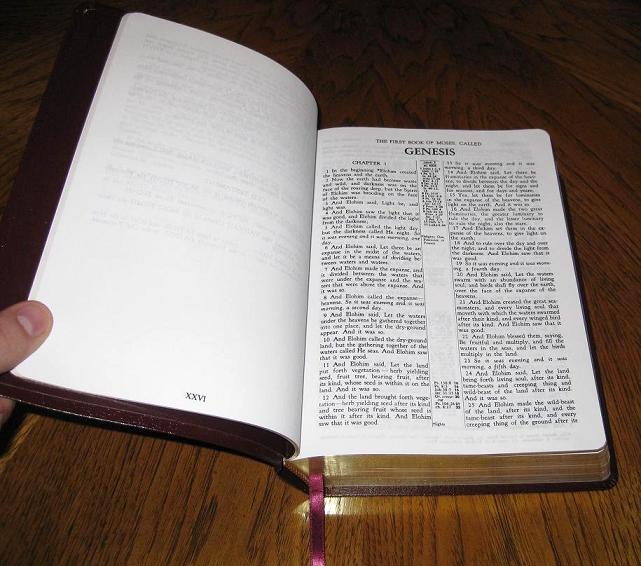
As mentioned, the book does not open up flat due to the glued binding, so at Genesis 1 I have to hold it open. Notice the verse format and center column references.
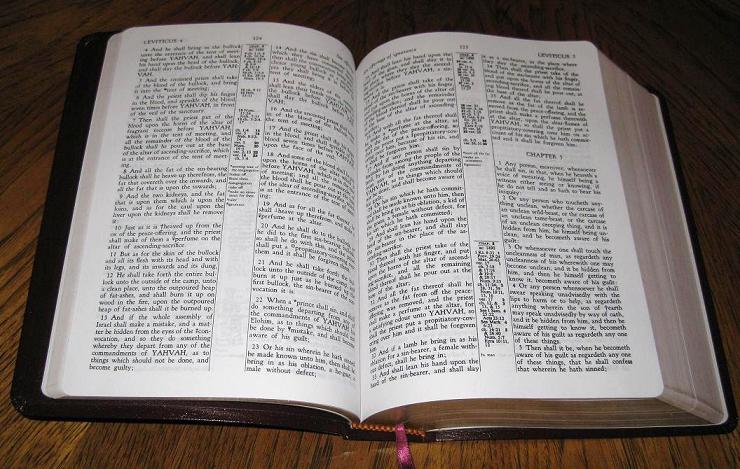
Once we get into Leviticus, it will stay open on it's own. Notice the subject heading on the inside of the header at the top.
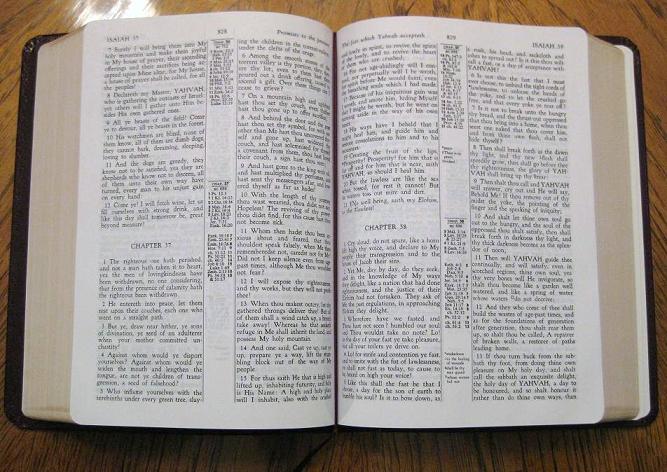
Here it is flat. From this angle it is very easy to see the print quality, text type, cross references/footnotes and subject headings.
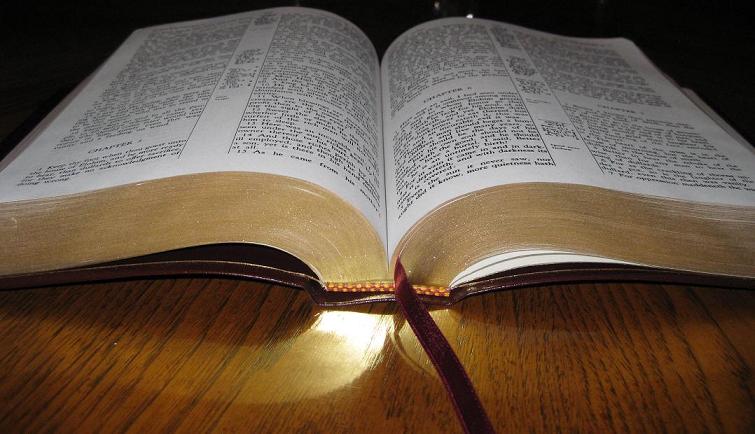
Very flush page edges with the nice gilded edges.
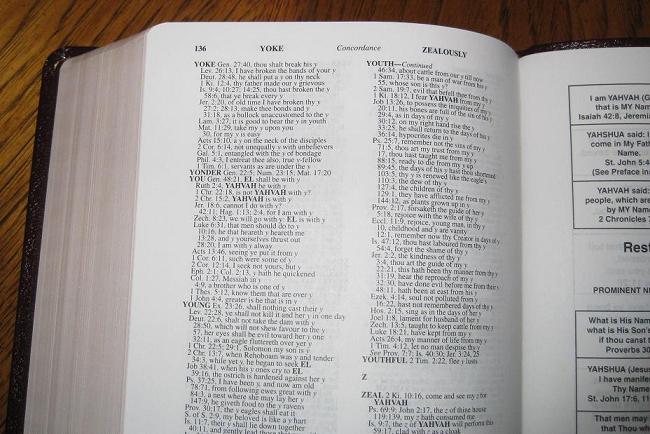
Here's a sample of the concordance at the last page. Again, it's very exhaustive which is nice to see in a Sacred Name Bible.

There's not too much of a flex here due to the glued binding and bonded leather, but it's better than the SSBE. Again, the pages are nice and flush. Notice the length of the ribbon marker.
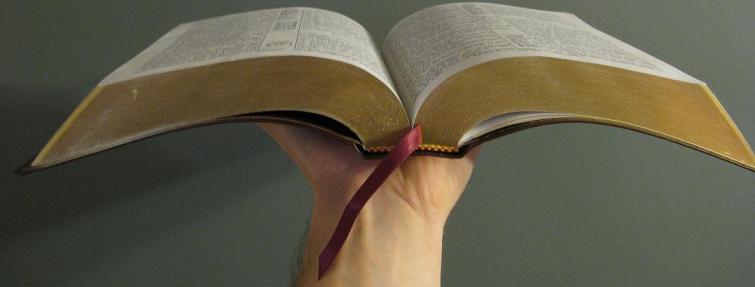
If you're reading near the center, this can be a very nice version to hold in the hands.
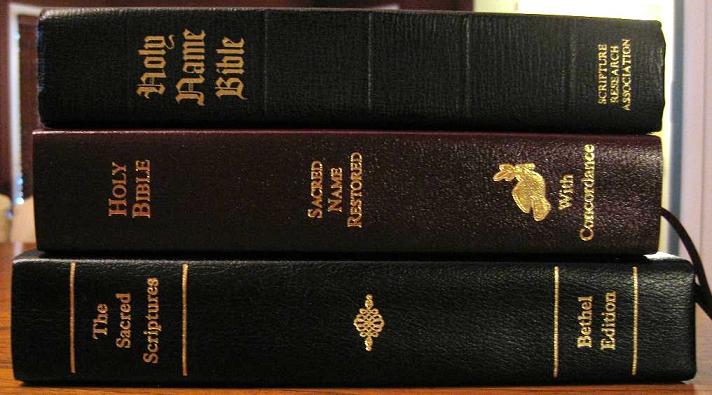
Here it is compared to the Holy Name Bible and the Sacred Scriptures: Bethel Edition. Average thickness and just as short as the HNB.
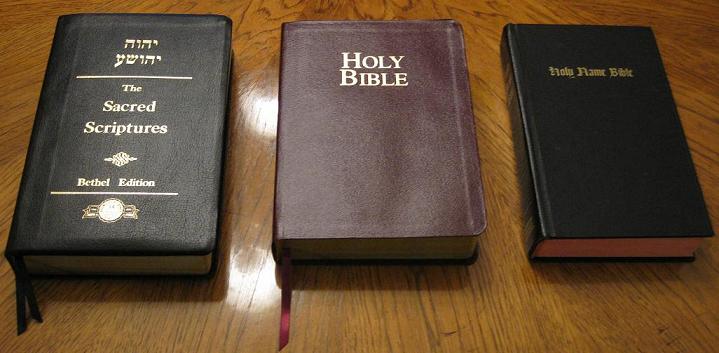
From the front, here you can see that it's wider than the HNB and shorter than the SSBE, a very good size!
~~~~~~~~~~~~~~
RETURN TO HOME PAGE